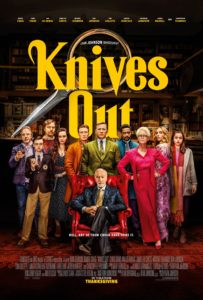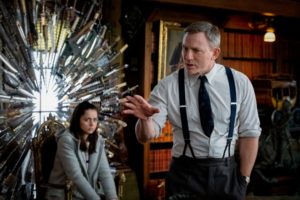One Liner Review:
A pretty cool murder mystery, set in a mansion, with a whole group of suspects.
Brief Review:
This is the kind of fantastic murder mystery that we’ve been waiting for. They don’t make these kinds of movies very often anymore, and that’s a real shame. Because it’s an incredibly fun genre. But part of the problem is that the genre has such clear defining rules, (the mansion, the rainy night, the multiple points of view, the hidden passageways,) that if we did get a lot of these movies, the rules would start to feel like cliche’s and become stale and tiresome. Since we don’t get many of them, when one comes our way and it is as smart as Knives Out, it’;s something worth celebrating. This movie is a lot of fun. It combines mystery and comedy, (just like Clue did, a movie that clearly inspired this one and even gets a shoutout – the board game, anyway.) Knives Out is about family members, and not strangers, but other than that it pretty much checks all the boxes. And it does this while still feeling like something completely fresh, creative, and new. That movie goes off the rails a tiny bit here and there, in the second half, but for the most part, it’s a pretty fantastic film.
REVIEW:
Wow! What a fun movie. Here’s a Who Dunnit murder mystery inside of a mansion, the likes of which we haven’t seen in ages. Agatha Christie got the genre started off, (in terms of books, anyway,) with Murder On The Orient Express and And Then There Were None. Then came Murder By Death, a pure slapstick parody starring Peter Faulk. But it was Clue that really brought things to the next level. That was the best movie in the genre. Since then, there have been a handful of incarnations, from Identity to the Hateful Eight. And they all tend to be pretty terrific films. Knives Out is no exception.
The movie’s writer / director, Rian Johnson, is clearly a fan of the genre, and of Clue in particular (there are multiple references to that 1985 film, including a direct call out involving a line about a Clue board, to at least two riffs on the jokes – the dogs attacking people, and a line – “No, we can’t leave, or no we can’t ask why?” But the movie also clearly has carved out its own path. There isn’t a series of murders, but only one possible murder. It also might possibly be a suicide.The characters aren’t strangers, but family members. There is a detective in the house, working the case. And the story isn’t about a single night, but about the days that follow, with characters reliving and retelling the events from that night when our victim was killed.
The idea to have the detective, (Benoit Blanc, played deliciously by Daniel Craig,) spend the first half of the movie interviewing each suspect leads into a Rashomon-like storyline. That’s the movie that generally gets credited with first showing the same story shown multiple times, each time from a different point of view. It is a cool technique that has been used in many movies since – from The Man Who Shot Liberty Valance to Jackie Brown. And yes, like most movies in this genre, Rashomon takes place with characters sitting in doors while a storm rages outside, all around them.
Here, in Knives Out, the multiple point of view, Rashomon technique doesn’t happen quite as often as one might hope. There’s the blowing out of the birthday candles (each character tells the story of that night with him or her standing behind the victim, Harlan Thromby, when he blew the candles out,) to the night when this man was playing a game with his caretaker, Marta, (Ana De Armas,) and dropped the board, only for Joni (Toni Collette,) to come up and check on him. There’s also the situation where Ransom (Chris Evans,) left Thromby’s study in a rage after having a talk with him, and storming out of the house. Something tells me there are actually more of these multiple point of view scenes buried in here, and that this movie will require multiple viewings to catch them all.
Harlan Thrombey (played by Christopher Plummer,) is a the best-selling author of a mystery novels series, which explains the knives sculpture he keeps in his living room (and which appears on all of the trailers.) It’s basically a circular dart board or wheel with tons of knives glued around it, all pointing toward the middle. And each suspect gets interviewed sitting in front of the sculpture. It adds to the humor, the title of the movie, and even something that happens in the second half. What it doesn’t do is make a whole lot of sense. Would you ever have murder suspects sitting next to a tray full of knives, for example, while they were being interviewed? But for artistic integrity and a humorous look , the idea works.
The movie opens with the different family members arriving at the house, one by one, to be received by the detectives for their interviews. The detectives refers to not just Benoit Blanc, but also Lakeith Stanfield, (so good in the TV show Atlanta,) and also a white, naive, rookie detective. Blanc is the private investigator who does not know who hired him or paid his salary. Harland has been found dead, up in his attic bedroom with his thrust slashed. Since the time of death appears to be sometime the previous evening, each suspect has been called in to recount his or her memories from that fateful night. And that’s where our story begins.
We get to know the different suspects through their stories. And it seems that just about everyone was using Harland to give them money. In the case of Walt Thrombey, (Michael Shannon,) he was employed by his father to be the manager of the book selling. In the case of Joni, she was being given money to put her daughter (and Harland’s granddaughter,) to college. And in the case of Ransom, Harland was just giving him money to live on, supporting his bachelor lifestyle of never needing to get a job.
Each suspect of course tells about his close he or she was with Harland. But when they talk about the others, their true colors come out. They all have different interpretations of what they saw happening between Garland and his other family members that night. And just like in Clue, where all the guests were being blackmailed and we’re called to the mansion to finally confront their blackmailer, Harland devises once and for all to cut all of his family members of Mc on the same night. And in some cases to let them know that he’s aware is what they’ve been up to, (like Joni who is actually stealing from Harland.)
And so we get the story of the interviews in the first half of the film. But we also learn of what really happened that night, and then watch as one character tries to cover it all up. What’s unusual about all of this is that we usually don’t get to see the truth about what happened to the victim until the end of the movie, but here they give it to us in the middle. It’s a genius Kobe because the second half is then spent seeing the situation through the eyes of this character who is trying to fool the detectives. And there are plenty of other secrets and twists along the way.
The movie works on nearly all levels, including its use of comedy, flashbacks, a character who vomits when she tells a lie, and multiple points of view. If there’s one thing that doesn’t white work as well, however, it’s when the characters leave the house. Going off to a diner down the block is one thing, but when new crimes start to get committed away from the mansion, the story feels like it’s reaching two far. Keeping the characters contained is what usually works best about these movies. But this film wants to push the boundaries. Just like director Rian Johnson’s Star Wars entry (his last movie before this one,) The Last Jedi, when he starts doing things simply because they go against the usual rules of what we’d expect, it’s a problem. Still almost the entire movie is petty great.

